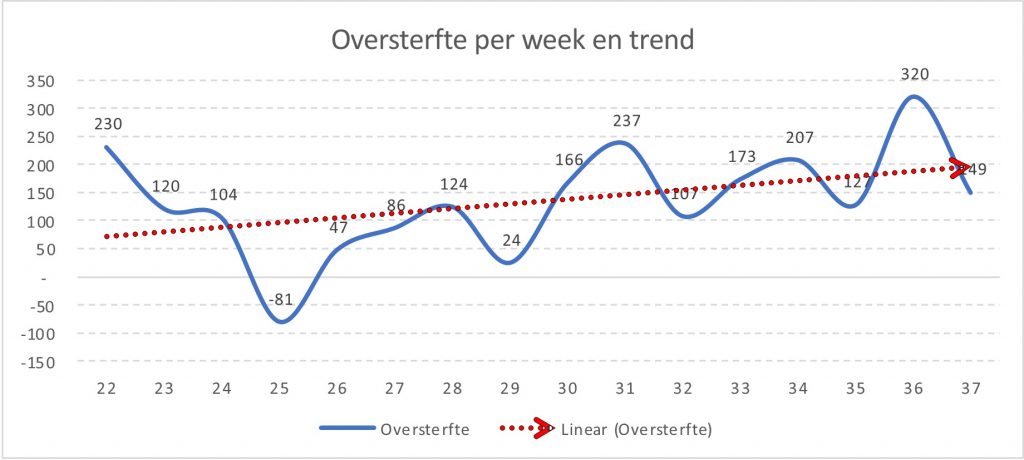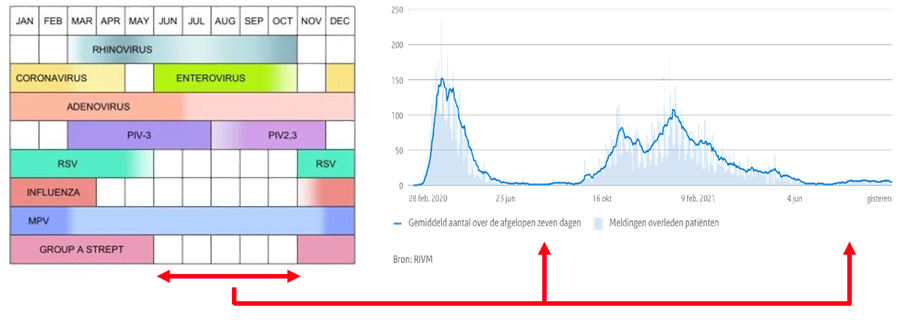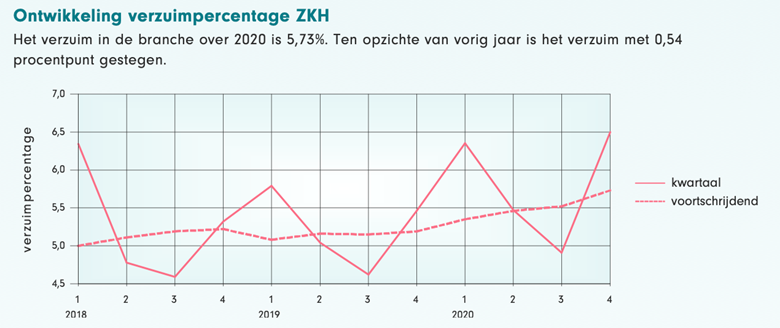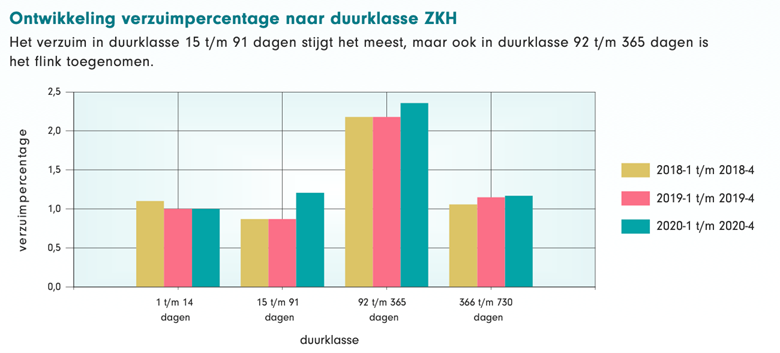Occasionally I post a guest post on my blog. Usually these are documents that were sent to me spontaneously. Very remarkable is the following argument regarding my speculations about the high mortality of recent months. They are all assessed numerically. Why I hesitated to post it is that it was sent to me on condition of anonymity. There are fears of repercussions from employers or clients. Nevertheless, it contains interesting calculations that estimate the probability of various causes of death. As a thought fodder, I found it interesting enough to post anyway. Read it as if it were a leaked internal memo from WEF or from the Ministry of Health, Welfare 😋 and Sport. The article is download here as PDF.
REASON: Article on virusvaria.nl
SUBJECT: Structural excess mortality in the summer months 2021
DATE: 30 September 2021
On the website virusvaria.nl an opinion article about the recent development of excess mortality in the Netherlands. This memorandum discusses the developments indicated.
In accordance with figures published by Statistics Netherlands (source 1) and RIVM (source 2) there is no doubt that there will be structural excess mortality in the summer months of 2021. Excess mortality is understood to mean: a higher number of deaths than expected on the basis of circumstances that can be considered normal (seasonal pattern, weather conditions, etc.). Statistics Netherlands regularly adjusts its forecasts with regard to the expected number of deaths per week (source 3). Based on these figures plus the number of deaths per week with corona (*) as reported by the RIVM, the total excess mortality for the Netherlands is included below:

Based on this data, no less than on balance 77% of excess mortality in the period week 22 to week 37 not declared due to deaths with corona (*). We also note that such excess mortality is in fact already visible from week 12 2021. Statistics Netherlands (CBS) also notes excess mortality (source 9).
Based on the figures presented, there is a trend development in which excess mortality increases over time:

Looking at age, this situation is mainly caused by excess mortality in the age group of 65-80 years. This development is presented as follows:

In this age group, an average of no less than 84.9% of all excess mortality is caused by deaths of people who have not died with corona (*). The number of people who died with corona (*) (15.1%) is low compared to apparent other causes.
Graphically, the image is as follows:

Apparently there is something other than corona going on.
The question that arises: what could be the cause of this structural excess mortality?
Possible causes in perspective:
Theorem: there are seasonal effects
In every year there are seasonal effects in which, for example, excessively hot summers give rise to an increased mortality rate in the elderly. We do not consider this to be significantly applicable in 2021 because there are weekly expectations determined by CBS, with seasonal effects already included in the forecasts. In addition, the summer in 2021 was considerably cooler than in previous years, so this effect cannot be the cause of the above phenomenon.
Apart from that, we note that in the summer months the mortality due to respiratory diseases such as corona, influenza, etc. is structurally lower than in the other months (source 4, source 2).

Thesis: CBS cannot forecast.
Poor forecasts can lead to large deviations from reality. Poor CBS forecasts are a possibility, although the CBS figures are the basis for various policy decisions in the Netherlands. Statistics Netherlands (CBS) figures are published continuously for external assessment and use. Therefore, this argument does not seem likely. As indicated, CBS regularly updates the mortality forecasts on a weekly basis, which means that the 2021 forecast includes mortality with corona (*), among other assumptions. On this basis, it is in fact expected that the non-corona-related excess mortality is even higher than presented above. However, we abstract from this effect here because it is not possible to determine exactly how cbs' mortality forecast was drawn up and which factors are included in the forecasts in which way.
Theorem: The excess mortality may be a coincidence.
Since there is apparently a (increasing) structural effect over the presented weeks, this is not the case. The effect outlined is also visible in European figures (source 5);
Theorem: The excess mortality presented is statistically irrelevant.
This is not the case on the basis of the available data, as shown by the figures below:

In the age group of 65-80 years, for example, excess mortality as a percentage of the total actual mortality is no less than 6.3% on average! Over the period presented, this concerns 929 more deaths than predicted by Statistics Netherlands. For comparison: in this period, 141 people with corona (*) died. The "A status" considered fatal disease for which the economy, society and social cohesion have been torpedoed and the Netherlands has an additional debt burden (government, companies and private) of approximately € 140 billion. The excess mortality presented is therefore statistically relevant.
Theorem: The excess mortality rates are caused by delayed care.
Countries with sufficient capacity, without delayed care, show the same excess mortality pattern. That said:
Due to corona (depending on the specific care segment more or less) delayed or reduced care, there may be a reason for (in the long term) occurring excess mortality. To this end, we distinguish between delayed care versus life-threatening deferred care. How can that be considered?
- An important element in deferred care is the available care capacity (practitioners, nursing staff, hospital beds, ICU beds, equipment, medication, etc.). Due to extra demand for care due to corona (and increased absenteeism among healthcare professionals), redeployment in the treatments must take place within the available care capacity. Due to a combination of population growth and multi-year cuts in healthcare, the care capacity in the Netherlands (also pre-corona) has come under pressure. If we compare some characteristics of the care capacity with the situation in, for example, Germany (source 6), we see the following picture:

- The increased absenteeism related to corona in 2020 was rather relative (source 12):
Absenteeism at hospitals in 2020 was 5.73% (2019: 5.19%). In terms of both absenteeism and absenteeism, this shows no reason to speak of an "unmanageable staffing situation" in hospitals as the basis for "a reservoir" of deferred care:


- In fact, the available care capacity in any country is used on an ongoing basis in terms of maximum occupancy rates. There are such financial incentives that practitioners and healthcare institutions realize higher income on balance with a higher volume of care provided. However, a significant part of the care is neither urgent nor life-threatening in the event of non-provision. Think of orthopedic procedures, stomach reductions, plastic surgery (too large ears), non-urgent dental reconstructions, non-urgent psychiatric care, physiotherapy, occupational therapy, etc. Ergo: a significant part of the care delayed by corona has no effect on the future mortality rates that we currently assess (weeks 22-37).
- Due to patients' fears of being infected with corona by healthcare providers and institutions, many medical appointments have been postponed or cancelled over time. We consider it plausible that this concerns appointments or medical treatments of which the patient generally considers that the urgency / degree of threat to life is limited. This "delayed care" is also not expected to have a significant effect on the currently observed excess mortality in the measurement period. All the more so since a significant part of such care has still been provided in the course of the corona period if doctor or patient have seen reason to do so. Moreover, the development of life-threatening tumours often takes considerable time, so it is unlikely that the presented excess mortality in weeks 22-38 (134 per week) can be entirely attributed to, for example, patients who have died of cancer. According to CBS, an average of 866 people died of cancer per week over Q1. An excess mortality from cancer would mean an increase of 15.5%.
- Life-threatening delayed care (relevant here because we are looking for causes for the excess mortality outlined) is very different from the "total" delayed care as regularly reported in the media (source 7). There are no indications that acute care or diagnostics have been postponed. "Code black" regarding treatments (choosing which patient is and which is not treated) has never occurred.
- An example of a randomly chosen (anonymized) hospital organization:

Explanation:
The above figures have been drawn up on the basis of published annual reports. We see a picture where in 2020 there was a significant decrease in the number of admissions and visits where many visits have shifted from physical contact to telephone contact. Hospitalizations decreased by 13.8%.
- The number of patients increased by 3.6%. However, this growth is only 17.8% explained by additional corona patients.
- 273 patients with corona have died. Over a period of roughly 10 months, that is 0.91 patients per day, which is only 0.93% of all hospital admissions in those 10 months. Total number of corona patients (1,233): over a period of 10 months, this is 4.11 patients per day, representing 4.21% of all hospital admissions in those 10 months. Only 0.62% of all patients!
- The number of employees (direct (hands at the bedside) and indirect functions (supporting in a broad sense)) has increased by no less than 3.2% in accordance with the 2020 financial statements. Consequently, the calculated ratio 'per bed' has also increased by the same percentage.
- But were many more employees sick in 2020? Well that was rather limited as indicated above (source 12).
- The expenditure in terms of personnel costs apparently did not suffer in 2020, which are excl. hiring increased by 9.6% of which 5% CAO increase for staff.
General
How can it be that due to lack of capacity in hospitals there is so much delayed care (regardless of whether it can be seen as critical)? The number of beds (although perhaps structurally tight) is not the same as in 2019. It is not due to the absenteeism of the staff. Although this is slightly higher in 2020, there were also more employees. As a result, the number of non-sick employees increased by 2.6% on balance compared to 2019. The impact of the number of corona deaths in hospital is not due to the impact (0.93% of all hospital admissions). The number of corona patients in the hospital is not to blame: 0.62% of all patients. And the number of hospital admissions in 2020 decreased relatively slightly compared to 2019: -13.8%, which can be assumed that this was not emergency care.
- One would expect that the relative amount of life-threatening delayed care in countries with substantially more available care capacity (Germany compared to the Netherlands, for example) is lower than in countries with a tighter care capacity. However, excess mortality in the countries around us shows the same picture as in the Netherlands (source 5).
In other words, it cannot be the case that life-threatening delayed care is the main explanation for the presented excess mortality figures. After all, excess mortality in Germany would be considerably lower than in the Netherlands. However, that is not the case.
Explanation:
- on balance, corona has had broadly similar effects on society in the Netherlands and Germany (including that citizens have voluntarily postponed care, lockdown and movement restrictive measures, vaccinations in 2021);
- based on largely harmonized European healthcare regulations, the organization of care supervision, internationally applied scientific insights, internationally used equipment, diagnostics, medication and treatment methods (viewed across the entire healthcare domain), we do not see any significant deviations between the Netherlands and Germany with regard to the impact of corona on the degree of life-threatening delayed care;
Research in England
The "plausible logic" that is followed in this respect is that delayed diagnosis and treatment (in the long term) leads to poorer treatment results or life expectancy of patients. This reasoning is imitable, although it only applies to life-threatening deferred care. This is only a limited part of the total care as discussed. In England, research (source 11) has been published into the relationship between excess mortality (also there) and delayed care. The study finds:
- the number of deaths from these diseases has risen
- Diagnostics and treatments for these diseases were lower from 2020 due to COVID (delayed care).
However, we note:
- all Diagnostics and treatments were lower due to covid, for all Syndromes
- there is no causal association between higher death rates from these diseases and delayed diagnosis/treatment demonstrated. The explicit relationship between the two is not demonstrated but assumed. The study explicitly states:
"Although it is not possible to quantify the full impact of the delays in presentation, consultation and diagnosis stages at this point, the literature shows that these treatment delays are likely to lead to poorer health outcomes for patients." - If excess mortality based on deferred care were so obvious, the mortality forecasts periodically adjusted by CBS would undoubtedly have been adjusted accordingly. Nevertheless?
There is a situation in which it should actually be expected that, due to the much more limited care capacity, more life-threatening delayed care should occur in the Netherlands than in Germany. However, excess mortality rates are similar.
On that basis, there must therefore be at least one other dominant explanatory factor in the excess mortality figures.
Theorem: Excess mortality due to vaccination.
As a result of the vaccination strategy used in the various countries, the elderly and vulnerable were vaccinated first because these groups were most likely to suffer from serious illness or death from covid(*). It is striking in the above figures that excess mortality is mainly caused by the age group 65-80 years. A group of which in spring 2021 the vast majority of people have now been vaccinated on the basis of vaccination programs. The vaccination rate among younger categories is currently (significantly) lower.
Could the excess mortality in the summer months be related to the vaccination campaign?
We cannot say that at the moment. But don't rule it out in advance either.
In case of would be of excess mortality as a result of the vaccinations, it is plausible that:
for the shorter term in particular (ICD-10 classification):
– D50-D89 diseases of blood and blood-forming organs and disorders of the immune system
– I00-I99 diseases of the cardiovascular system
could occur as an increased cause of death (excess mortality) and
on the medium and longer term:
– C00-D48 neoplasms (cancer)
to an increased degree (excess mortality) as a cause of death could occur.
Statistics Netherlands (CBS) only publishes deaths by cause of death on a quarterly basis. Reporting on Q2 will take place in the coming weeks. We are very curious about this publication. We also note that CBS reports deaths by cause of death on the aforementioned ICD qualification. However, it does so infrequently. In fact, the quarterly reporting also takes place in a thickened manner without the underlying details being made available. The currently most recent detailed figures for the cause of death for 2020 were published on 18 August 2021 (source 10). In the context of the current crisis in the healthcare sector and the fact that Lareb is unable to carry out proper research into death by vaccination (source 8), we consider cbs' publication frequency to be far too low for active government policy. If the figures show that excess mortality is related to the vaccination campaigns, it is socially undesirable that this is only shown much later in the figures.
Implausible options
We do not consider the possible other causes mentioned by virusvaria.nl to explain the excess mortality to be sufficiently plausible.
- general socio-economic disruption (remark: diffuse not further qualitatively analyze "cause");
- crime and/or domestic violence (remark: Based on recent "murder and manslaughter" figures on deaths from such causes, none of this is apparent. In total, for example, this number of deaths in 2019 was 125 on an annual basis: only 2.4 per week with an average excess mortality per week of 134). The vast majority of murders do not take place in the 65-80 age group, which is important for excess mortality;
- restriction of freedom, enforced changes in behaviour, deprivation of future prospects (remark: a possible increase in the number of suicides can be seen from the upcoming CBS figures, although we emphatically expect that this will not be a material explanation of the excess mortality outlined, on average the number of suicides in the Netherlands per day is about 5. The average weekly excess mortality is 134. In addition, it is not realistic to expect that exorbitant suicide will occur, especially in the age group 65-80 (see analysis above). Given age, this group in particular has learned to live with "modest future prospects");
- agony (remark: Fear of death, as a rule, is an effective mechanism for preventing death. In this sense, perhaps contributing to under-mortality);
- immunity-related, after two seasons of semi-isolation an immunity atrophy (remark: On the basis of publications, there is no indication of this, especially since deaths in the summer months due to, for example, respiratory diseases are very low and therefore cannot be a significant cause of the excess mortality outlined. It can be a occurring effect, but emphatically not in the summer months).
Call
In case the reader has any other possible explanations for the observed excess mortality, we are highly recommended. We will then try to test, on the basis of available figures, to what extent these can be regarded as explanations. You can email substantiated comments.
(*) due to inadequate registration methods in the event of death and, for example, the non-systematic performance of necropsy/autopsy after death, the figures of CBS and RIVM on deaths related to corona are unreliable. In all cases, there is no certainty to what extent a death is due to / due to corona or that the deceased died with corona while the actual cause of death was another. The number of deaths from corona is therefore expected to be lower than the number of deaths from / due to corona. Incidentally, registration with Lareb is also incomplete as a basis for analyzing the effects of vaccination (source 8).
Sources used
Sources dated September 29, 2021.
Eucalyptic Society
The Eucalyptic Society (Est. 2015) is a group of Dutch academics, data analysts and critical thinkers, who follow social developments with a keen eye and assess them on the basis of rearrangement and interpretation of available sources and figures. The objective is to make judgments about current phenomena in the economy and society on the basis of underlying facts. The Eucalyptic Society is completely independent, operates selflessly and has no relationship with government institutions and/or the business community in the areas studied.
“The witch Eucalypta (in the capacity of government, institutions and the press) makes it very difficult for Paul the forest gnome (the normal man) with her tricks and tricks. But fortunately Paul gets help from his many (right-thinking) friends in the forest (society).”
The society currently has a membership freeze.
Disclaimer
We do not accept any liability or justification for the basic figures used in this memorandum as obtained from the aforementioned sources. We also do not accept any liability for the effects of any policy pursued on the basis of analyses published by us. Policymakers always bear their own responsibility for assessing the data, developments and choices relevant to their policy at that time.

